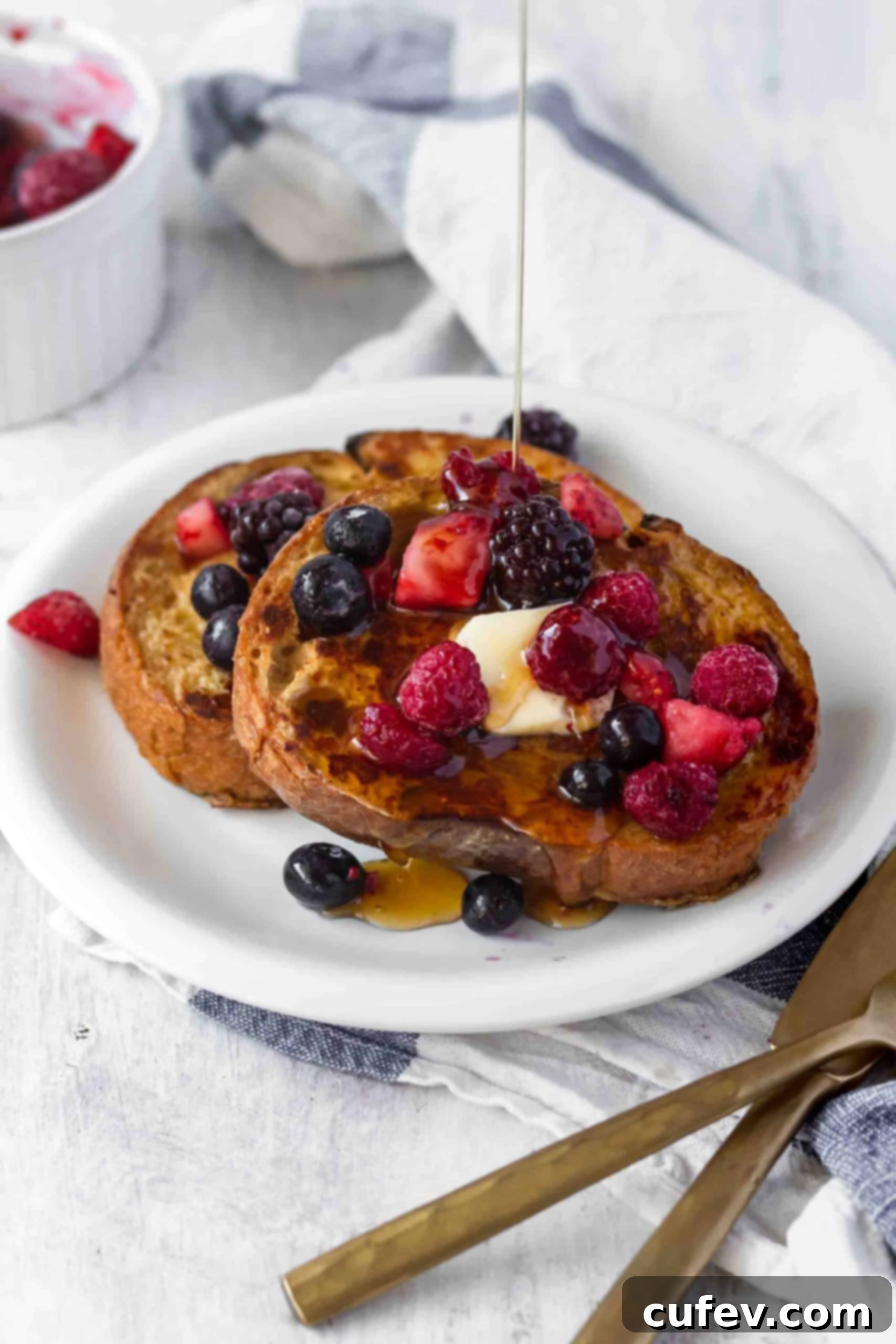The Ultimate Guide to Delicious Vegan French Toast: Easy, Fluffy, and Plant-Based Perfection
Experience the magic of vegan French toast – a delightful, plant-based twist on a classic breakfast that’s surprisingly easy to make and incredibly delicious! This recipe, featuring a unique batter of creamy coconut milk and versatile chickpea flour, promises a breakfast or brunch experience that is both comforting and deeply satisfying. Whether you’re a devoted follower of a plant-based lifestyle or simply looking to explore new culinary horizons, this fluffy, golden French toast will win you over with its irresistible texture and rich flavor. It’s the perfect way to start your day, proving that vegan alternatives can be just as, if not more, amazing than their traditional counterparts.
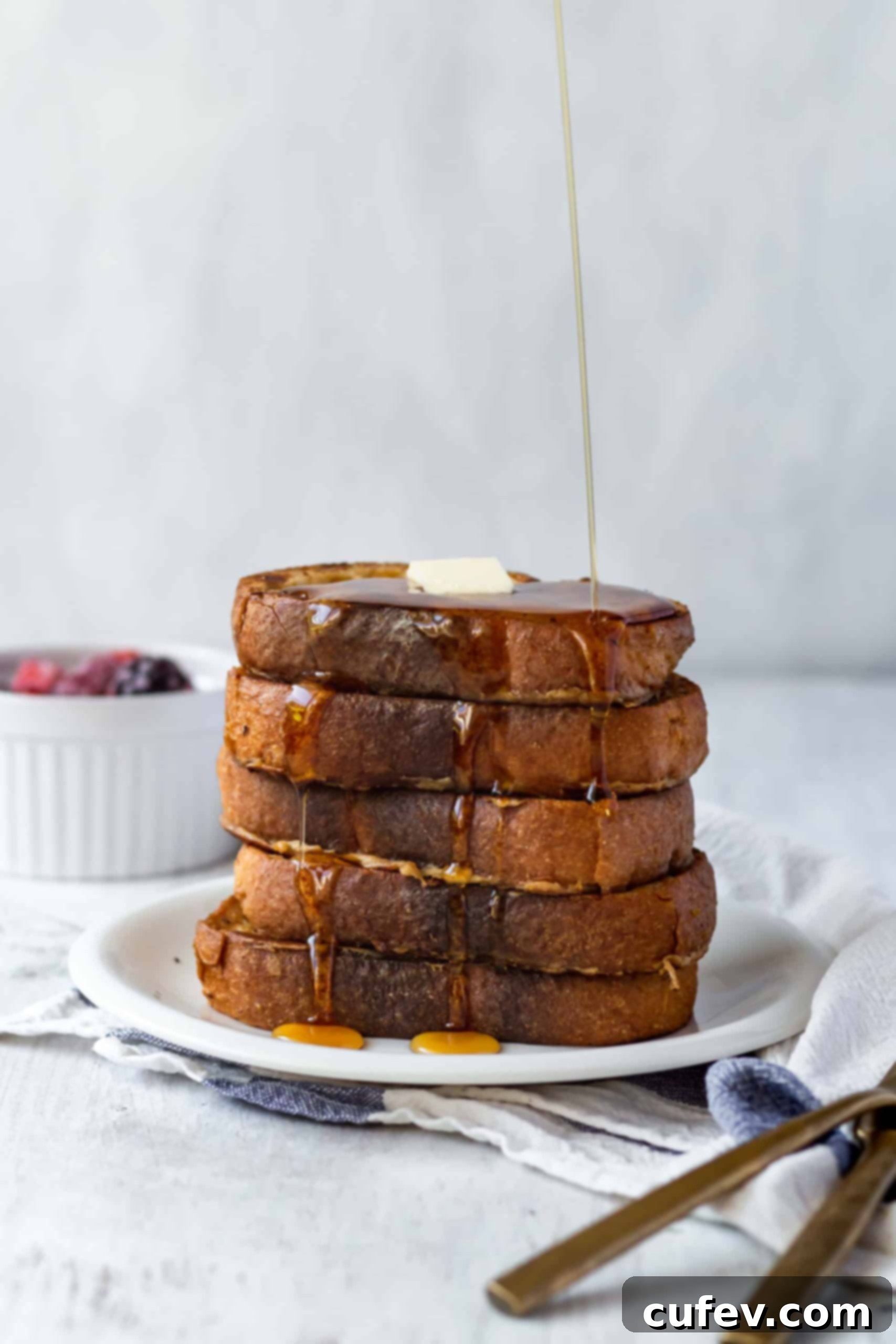
What is Vegan French Toast?
Traditional French toast, a beloved breakfast staple, relies heavily on animal products like eggs and dairy milk to create its signature custardy texture and golden-brown crust. For those following a vegan diet, or anyone with allergies to eggs or dairy, this classic dish has long been off-limits. However, the culinary world has evolved, and now, vegan French toast offers a fantastic, cruelty-free alternative that rivals the original in taste and satisfaction.
At its core, vegan French toast reimagines the classic by replacing animal-derived ingredients with plant-based substitutes. Instead of eggs, which act as a binder and provide richness, various vegan alternatives can be used. Common choices include ground flaxseed or chia seeds mixed with water (creating a “flax egg” or “chia egg”), cornstarch slurries, silken tofu, or specialized commercial egg replacers. For the milk component, a wide array of non-dairy milks like almond, soy, oat, or cashew milk can be used to add moisture and flavor.
Our specific take on vegan French toast stands out by utilizing chickpea flour, also known as besan flour, as the primary egg replacer and binder. This unique choice, combined with the creamy richness of coconut milk, nutritional yeast for a subtle savory depth, and baking powder for a light, fluffy texture, creates a truly exceptional batter. Chickpea flour provides the ideal consistency and helps achieve that golden crust, while coconut milk infuses each bite with a luscious, indulgent quality. This combination ensures that every slice of vegan French toast is wonderfully moist on the inside and perfectly crisp on the outside.

Where Can I Buy Chickpea Flour?
Chickpea flour, also widely known as gram flour or besan flour, is a fantastic pantry staple for any plant-based kitchen, especially when making our delicious vegan French toast. Its unique binding properties and slightly nutty flavor make it an excellent substitute for eggs in many recipes. While it might seem like a specialty ingredient, chickpea flour is becoming increasingly accessible and can be found in several places.
Typically, you can find chickpea flour in the ethnic foods aisle of larger supermarkets, often near other Asian or Indian products, or sometimes with gluten-free flours. It might also be located in the section dedicated to dry beans and legumes, given that it’s made from ground chickpeas. Many health food stores and organic grocery stores will also carry it. Don’t be surprised if the packaging refers to it as “besan flour” – this is simply another name for the same product, commonly used in Indian cuisine.
If your local grocery store doesn’t stock it, or if you prefer the convenience of online shopping, chickpea flour is readily available on Amazon and other online retailers. Buying it in bulk online can often be more cost-effective if you plan to use it frequently. It’s a versatile flour that’s also excellent for making savory pancakes (like Indian dosas or French socca), thickening sauces, or creating gluten-free batters, so it’s a worthwhile ingredient to keep on hand!
Is Vegan French Toast Healthy?
When considering whether vegan French toast is “healthy,” it’s important to approach the question with a balanced perspective. Like many indulgent breakfast foods, French toast is often enjoyed with generous toppings of syrup and other sweet additions, which can certainly boost the calorie and sugar content. So, I wouldn’t go as far as to label it a health food, especially if you’re dousing it with a “healthy” amount of maple syrup! Perhaps it’s healthy for the soul – offering warmth, comfort, and a delicious start to the day.
However, when compared to traditional French toast, our vegan version does offer some notable nutritional advantages thanks to its star ingredients. Chickpea flour, for instance, is a nutritional powerhouse. It’s naturally gluten-free and typically lower in calories and carbohydrates than traditional wheat flour. More significantly, it’s considerably higher in protein and dietary fiber, which can help promote satiety and support digestive health. Chickpea flour is also rich in essential vitamins and minerals, including folate, iron, magnesium, and potassium. These nutrients play crucial roles in energy production, blood cell formation, and maintaining healthy bodily functions.
Coconut milk, while often perceived as high in fat, primarily contains medium-chain triglycerides (MCTs), which are metabolized differently by the body and can be a good source of energy. Crucially for those avoiding animal products, Chef’s Choice coconut milk (my favorite!) or any other brand of full-fat coconut milk contains absolutely no cholesterol. In contrast, eggs and dairy milk, key ingredients in traditional French toast, are significant sources of dietary cholesterol and saturated fat. By opting for plant-based ingredients, you inherently reduce your intake of these components, making vegan French toast a more heart-friendly option for many.
Ultimately, while moderation and mindful topping choices are key, this vegan French toast can be a more nutrient-dense and conscious choice for a delicious breakfast without sacrificing flavor or enjoyment. It offers a guilt-free indulgence that aligns with a plant-based diet while providing beneficial plant-based protein and fiber.
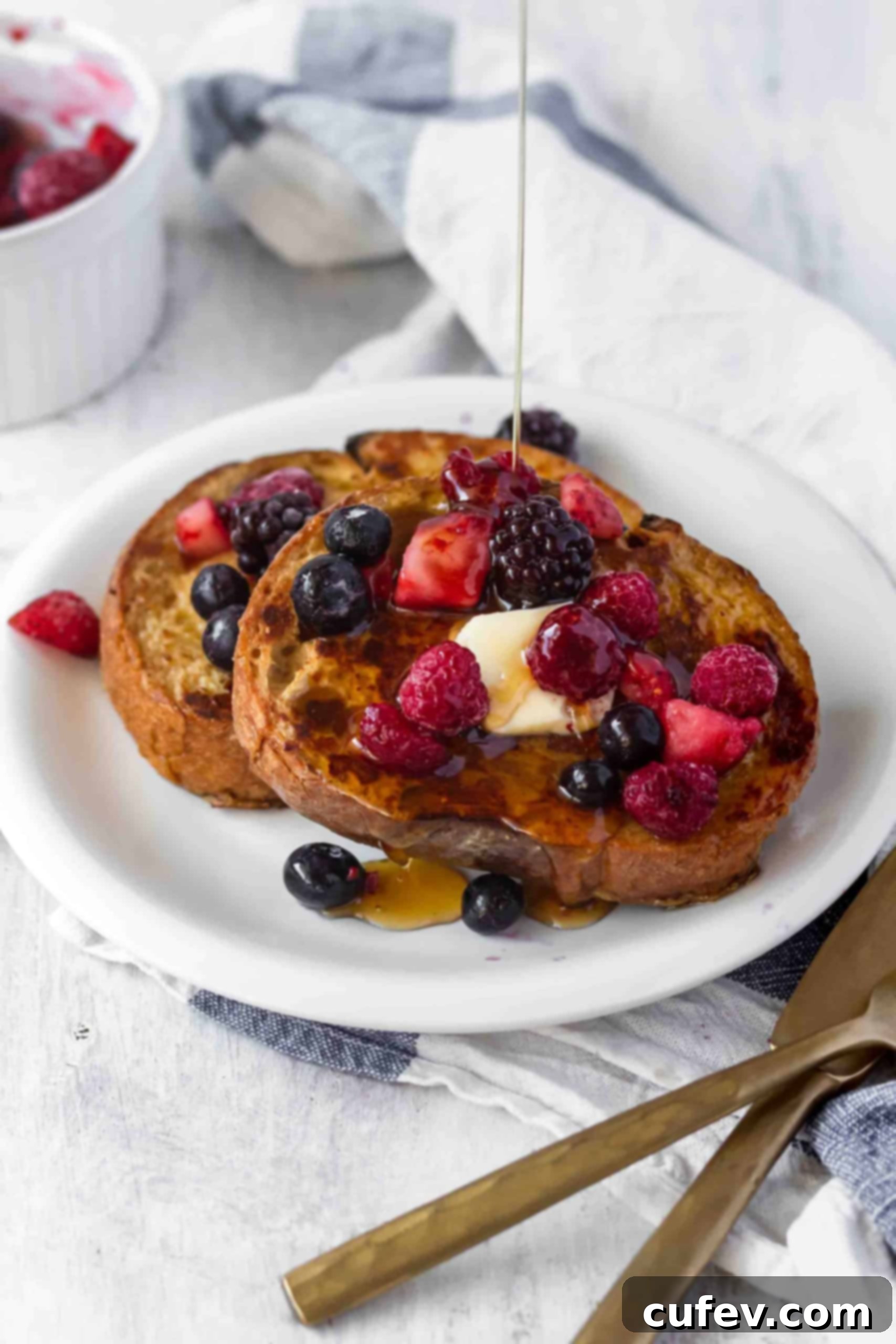
How to Make Vegan French Toast
Creating truly spectacular vegan French toast is simpler than you might think, and our recipe streamlines the process for effortless breakfast perfection. The key lies in balancing the flavors and textures to mimic the beloved classic, all while using wholesome plant-based ingredients. Here’s a detailed breakdown of the steps:
Step 1: Prepare the Batter
The foundation of any great French toast is its batter. In a medium-sized mixing bowl, begin by whisking together the dry ingredients: chickpea flour, fine sea salt, baking powder, nutritional yeast, ground cinnamon, and ground nutmeg. The chickpea flour acts as our primary egg replacer, providing structure and a subtle savory note. Baking powder ensures a light and fluffy interior, while cinnamon and nutmeg infuse the batter with warm, inviting aromas. Nutritional yeast adds a faint cheesy or umami depth that can enhance the overall flavor, though it’s optional if you prefer a sweeter profile.
Once your dry ingredients are well combined, gradually pour in the wet ingredients: water, creamy coconut milk, pure maple syrup, and vanilla extract. As you pour, continue to stir continuously. This gradual addition and constant stirring are crucial for preventing lumps and ensuring a smooth, homogenous batter. Keep mixing until there are no visible dry spots and the batter has a consistency similar to pancake batter – thick enough to cling to the bread, but still pourable. Once smooth, set the batter aside for a few minutes. This allows the chickpea flour to fully hydrate and the flavors to meld, leading to a better absorption and more even cooking.
Step 2: Cook the French Toast
Now it’s time to bring your creation to life! Place a nonstick skillet or griddle over medium heat and add a tablespoon or two of olive oil, or any other neutral-flavored oil suitable for frying. It’s important to let the pan heat up properly before adding the bread; a well-heated pan ensures a quick, even sear and prevents the French toast from becoming greasy. You’ll know the oil is ready when it shimmers slightly.
Carefully take a slice of bread and gently immerse it into the prepared vegan batter. Allow each side of the bread to soak for about 10 to 20 seconds. The soaking time is critical: too little, and the bread won’t absorb enough flavor and moisture; too much, and it might become overly saturated and fall apart. The goal is for the bread to be thoroughly coated but still hold its shape. Lift the soaked slice, allowing any excess batter to drip off, and then place it carefully into the hot skillet.
Let the French toast cook for 2 to 3 minutes on the first side, or until it achieves a beautiful golden-brown color and looks slightly crisp. The chickpea flour creates a wonderful crust that is both visually appealing and texturally satisfying. Once golden, use a spatula to gently flip the slice and cook the other side for another 2 to 3 minutes, or until it matches the golden hue of the first side. Repeat this process with the remaining bread slices, adding more oil to the pan as needed for each batch.
As each slice finishes cooking, transfer it to a plate or a wire rack. A wire rack is ideal as it allows air to circulate, keeping the French toast crisp while you finish cooking the rest of the batch. Serve immediately with your favorite toppings!
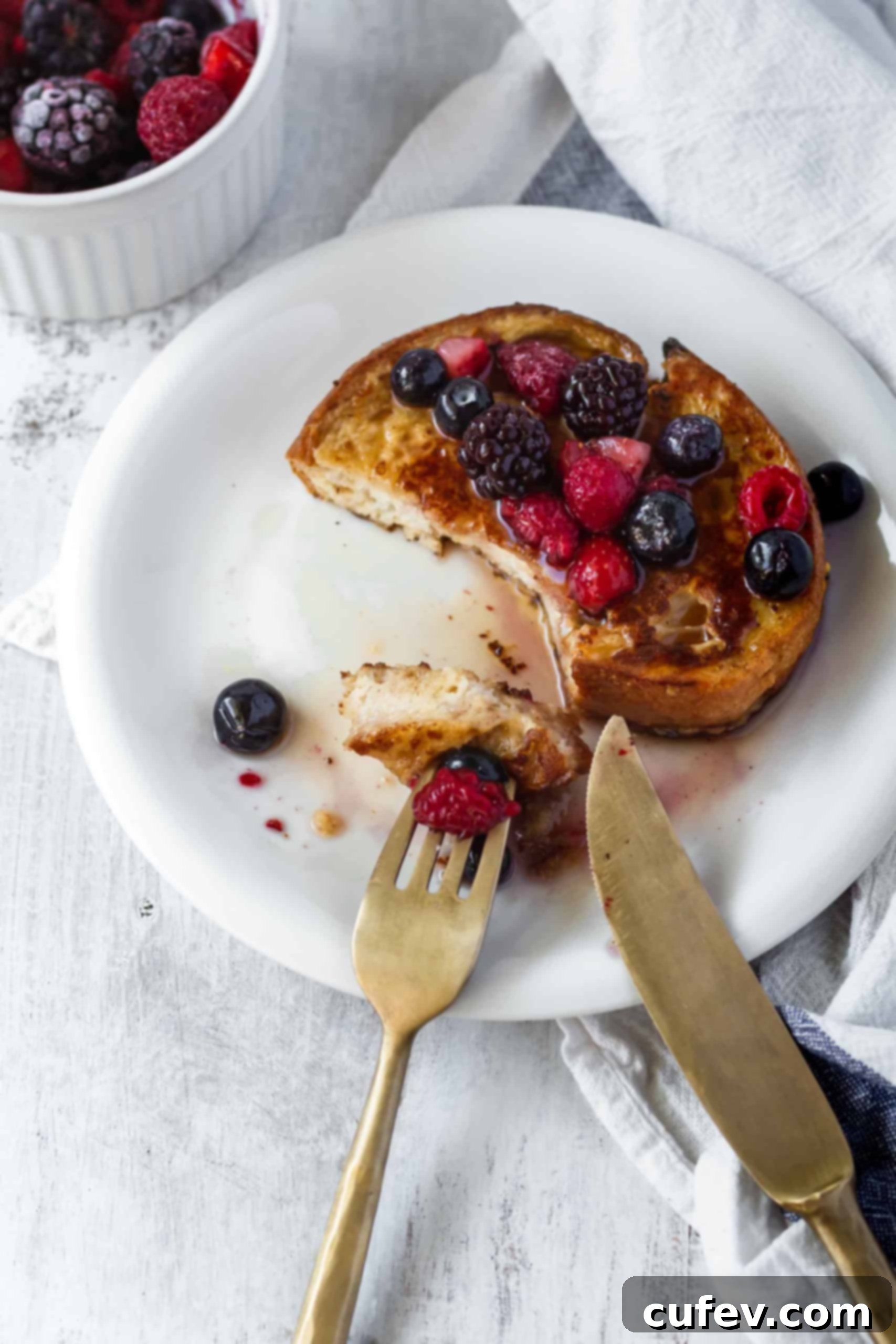
Tips for Making Delicious Plant-Based French Toast
Achieving the perfect vegan French toast is within reach with a few expert tips. These small adjustments can elevate your breakfast from good to truly extraordinary:
- Use Stale Bread for Best Absorption: This is a classic French toast secret that applies beautifully to the vegan version. Stale bread has less moisture, making it much more absorbent. This allows it to soak up more of the delicious chickpea flour batter without becoming soggy or falling apart in the pan. If you only have fresh bread on hand, you can lightly toast the slices in a toaster or oven for a few minutes to dry them out slightly before dipping. Good choices include sturdy white bread, challah (ensure it’s a vegan variety), brioche (vegan), sourdough, or thick-cut Texas toast. The thicker the slice, the better it can hold the custardy interior.
- A Nonstick Skillet is Your Best Friend: The chickpea flour batter, while magical, has a tendency to stick to less-than-perfect surfaces. Using a high-quality nonstick skillet or a well-seasoned cast iron pan is crucial for effortless flipping and achieving that beautiful, unbroken golden crust. Ensure your pan is adequately oiled and heated before adding the bread to prevent sticking from the start.
- Get Creative with the Toppings: While I’m a total sucker for the classic combination of vegan butter and pure maple syrup, don’t be afraid to experiment and personalize your French toast experience! The possibilities are endless.
- Fruit Power: Top with fresh berries (strawberries, blueberries, raspberries), sliced bananas, peaches, or a vibrant fruit compote. I always keep a big bag of defrosted mixed berries from Costco in my freezer for quick and easy topping.
- Creamy Indulgence: Add a dollop of vegan whipped cream or a scoop of your favorite non-dairy yogurt.
- Nutty Crunch: Sprinkle with chopped nuts like walnuts, pecans, or almonds for added texture and healthy fats.
- Sweet & Spicy: A dusting of powdered sugar is a must for many, and you can even add a pinch of cayenne or chili powder to your cinnamon sugar for a surprising kick.
- Chocolate Lover’s Dream: Drizzle with vegan chocolate sauce or sprinkle with chocolate chips.
- Savory Twist: For an unconventional but delicious take, consider a savory French toast with sliced avocado, a sprinkle of everything bagel seasoning, or even some vegan bacon or sausage on the side.
- Don’t Overcrowd the Pan: Cook French toast in batches to avoid lowering the pan temperature too much, which can lead to soggy results. Give each slice enough space to cook evenly and get beautifully golden.
- Keep Warm: As you cook multiple batches, you can keep the finished slices warm in a single layer on a baking sheet in a preheated oven at a low temperature (around 200°F or 90°C) until you’re ready to serve.
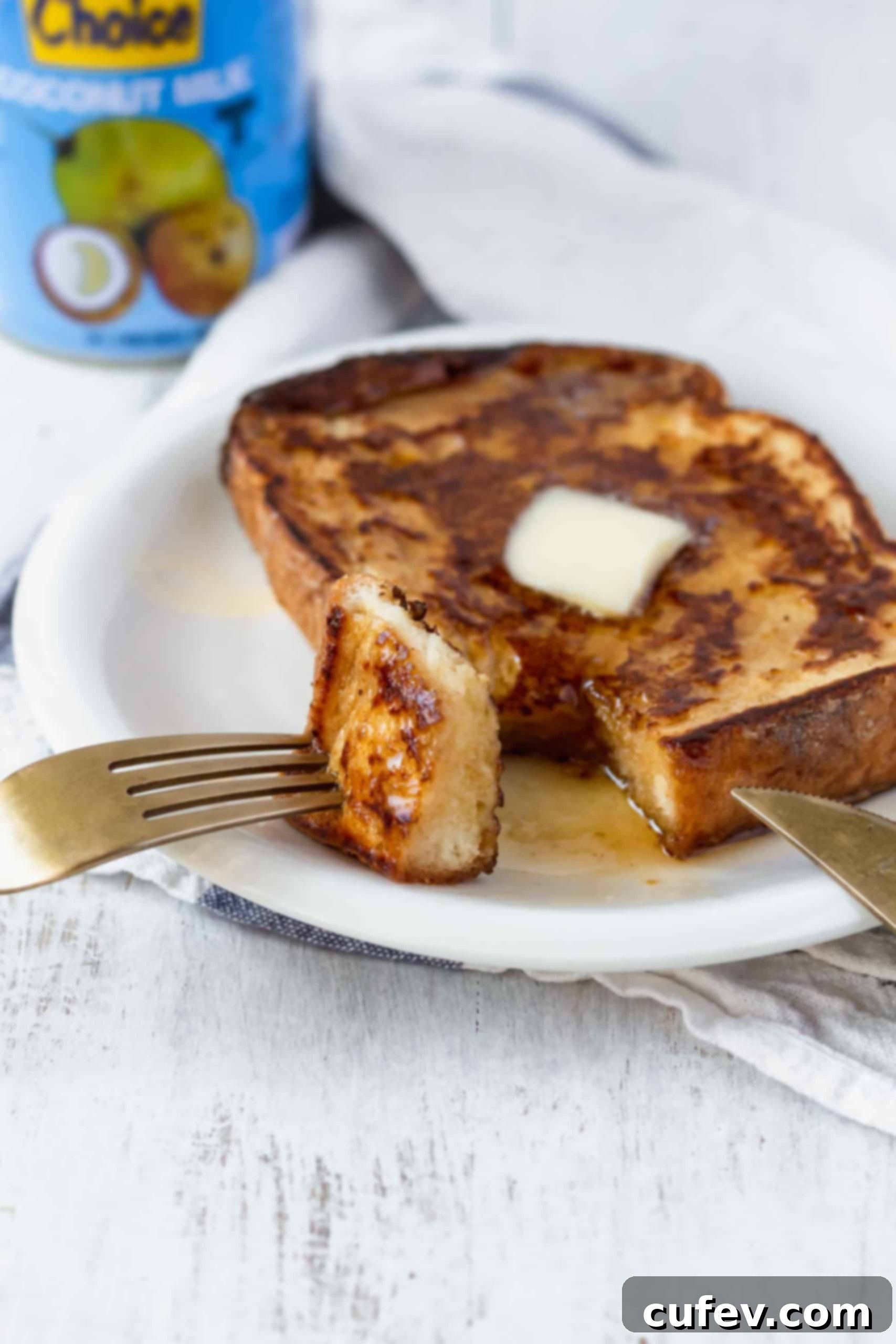
Other Vegan Breakfast and Brunch Recipes!
If you’re loving the plant-based breakfast journey, there are so many more delicious recipes to explore beyond this fantastic vegan French toast. Expanding your repertoire of vegan morning meals means more variety, more nutrients, and more exciting ways to start your day. Here are a few more plant-based breakfast and brunch ideas that are sure to delight:
- Vegan Cinnamon Rolls: Imagine waking up to the aroma of warm, gooey cinnamon rolls, completely vegan! These are surprisingly easy to make, yielding fluffy, soft, and incredibly delicious rolls with a sweet, spiced filling and a luscious glaze. Perfect for a weekend brunch or a special treat, they prove that you don’t need dairy or eggs for bakery-quality pastries.
- Homemade Gluten-Free Granola: If your mornings are a constant rush, preparing a batch of homemade gluten-free granola is a game-changer. This recipe is packed with wholesome ingredients, offering a satisfying crunch and customizable flavors. All you have to do in the morning is pour it into a bowl, add some non-dairy milk (like almond, soy, or oat), and you have a quick, nutritious, and delicious breakfast ready to go. It’s also excellent as a snack or sprinkled over vegan yogurt.
- Savory Arepas: For those who prefer a savory start to their day, you absolutely must try making arepas! These naturally gluten-free cornmeal cakes are wonderfully versatile. Once cooked, split them open and sandwich them with your favorite fillings. I highly recommend sliced avocados, seasoned black beans, or even some melty vegan cheese for a hearty and satisfying breakfast or brunch. They’re a unique and flavorful alternative to traditional pancakes or toast.
Exploring these diverse options will not only keep your breakfast interesting but also showcase the incredible variety and flavor that a plant-based diet has to offer. Enjoy discovering your new favorite morning meals!
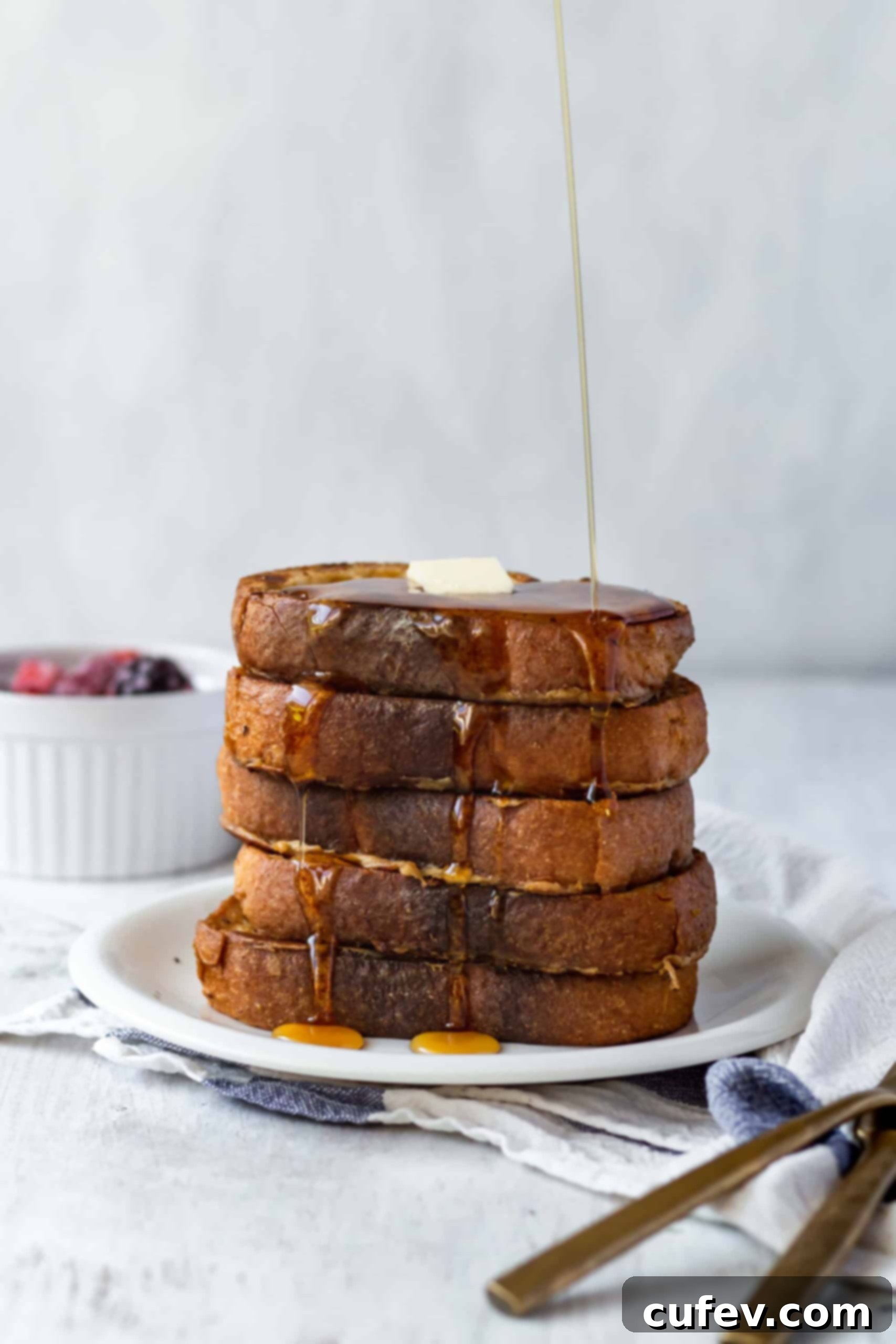
Vegan French Toast
Print
Pin
Rate
Ingredients
- 6-8 slices bread
- ⅓ cup / 35g chickpea flour
- pinch fine sea salt
- ½ teaspoon baking powder
- 1 tablespoon / 5g nutritional yeast
- 1 teaspoon ground cinnamon
- ¼ teaspoon ground nutmeg
- ⅓ cup / 80g water
- ½ can / 200g Chef’s Choice coconut milk
- 1 tablespoon / 20g maple syrup
- 1 teaspoon / 5g vanilla extract
- olive oil, for frying (or any other oil with a neutral flavor)
Instructions
-
In a bowl, whisk together the chickpea flour, salt, baking powder, nutritional yeast, cinnamon, and nutmeg. Stir while pouring in the water, coconut milk, maple syrup, and vanilla extract. Once the batter is smooth, set it aside.
-
Add oil to a nonstick skillet over medium heat. Soak a slice of bread in the batter for 10-20 seconds and put it in the pan. Let it cook for 2-3 minutes or until golden, and flip to cook the other side. Take it out onto a plate or wire rack while you cook the other slices.
